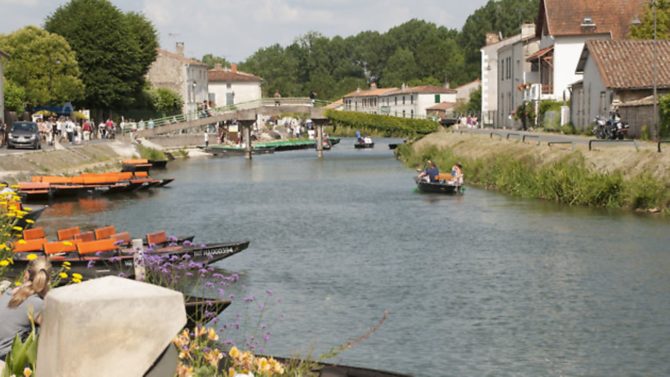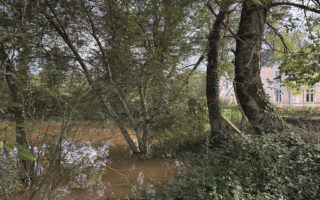Location spotlight: the Marais Poitevin

Exploring the magical waterways of the Marais Poitevin, Carolyn Reynier takes to life in ‘Green Venice’ like a duck to water and thinks you would too

The second largest wetland zone in France after the Camargue in southern France, the Parc Naturel Régional (PNR) du Marais Poitevin extends over around 100,000 hectares on the Atlantic seaboard. Its gateway towns are Luçon and Fontenay-le-Comte in Vendée in the Pays-de-la-Loire region, while to the south Niort and La Rochelle are préfectures of Deux-Sèvres and Charente-Maritime, both in Poitou-Charentes.
The main economic activities are agriculture, both cereal and livestock (mainly cattle); tourism – the park and its coastal resorts attract 1.5 million visitors a year; and conchyliculture (now there’s a word to add to your vocabulary), shellfish farming, with an average of 15,000 tonnes of mussels produced each year.
The PNR team are currently working on a marque parc label for certain products and services, for instance, marshland hay sold in garden centres for domestic pets. They are also developing a label for their beef and another for tourist accommodation.
“Generally, those who live in the Marais Poitevin choose to do so because of cheap property prices and an enviable environment,” says the park’s director Boris Sallaud. “There is no industry within the park, which is part of its attraction, so people usually work in La Rochelle and Niort.
Green Venice

Hervé Peyrard at Agence Sainte Marthe Immobilier in Niort, the eastern gateway to the Marais Poitevin, markets properties in the Venise Verte, the nickname given to the area of criss-crossing waterways, which includes the villages of Magné and Coulon in Deux-Sèvres, and Benet, Maillezais and Oulmes over the border in Vendée.
Here you can find old stone houses, often restored, including large country properties, longères with attic space above, and maraîchines, typical stone marshland properties with an upstairs floor. Prices can vary between around €130,000 for something small to renovate but nevertheless with a certain amount of space, to €350,000 for a fine, large property.
Most of Peyrard’s clients are buying main homes. If they choose the Marais Poitevin it may be for convenience – one person works in Niort, the other in La Rochelle, so they buy somewhere halfway; or it may simply be because they want to live in the countryside and are happy to commute daily to their place of work.
For working people, he explains that traffic congestion in the summer months can be a problem: “This is a popular tourist destination; if you live in Coulon or Magné, for example, or further out in Arçais or Sansais (communes near Niort but also on the edge of the Marais) traffic between June and September makes your daily drive to and from work un peu plus compliqué.
“It is not St-Tropez, of course,” he adds, “but we do notice it takes us longer when we are visiting properties in, say, Coulon, during that season than in November.”
Boat people
In Coulon, Patrick Braud works at the Maison du Marais Poitevin. He was born in Maillezais and started his working life there, in the heart of the Marais, at a sawmill cutting up poplars to make crates for fruit and vegetables.
As a youngster, summer jobs included work as a batelier taking people out on the water in a boat. “I was born in the Marais and couldn’t even walk before they put me in a small boat,” he says. In the morning before going to work his parents sent him off to water the garden or pick vegetables.
The scenery is particularly lovely here, and you can walk along the canals where the tree branches reach high above your head. Mainly ash trees are planted alongside the canals where their roots help stabilise the banks, and they provide good firewood too.
Pecking order
Heading west towards the ocean in Charente-Maritime, Marans (known as Marentus 2000 years ago) is linked by canal to La Rochelle. In 1930, this little town gave its name to the breed of deep russet-coloured, egg-producing Marans hens.
Julien Maitrehut and his father Michel at Marans Immobilier cover a sector south-east to Surgères, and in Vendée north-east to Fontenay-le-Comte and north-west to Champagné-les-Marais. In the very heart of the old town, the vieux Marans, you find old stone, terraced houses built into the ancient fortifications of the castle and other stone properties round about.
A small one-bedroom 48m2 semi-terraced town house with courtyard, in need of some attention, is on the market for €49,250, while if you prefer a more modern maison there are detached properties, mainly bungalows, on the outskirts of town for under €200,000.
In the surrounding countryside stone farmhouses for renovation are becoming harder to find, says Maitrehut; expect to pay €140,000-€150,000. He recently sold one that had been completely restored for €240,000. It was “around 130m2, with four bedrooms and a garage, in perfect condition”.
Your farm will usually come with some land (agricultural land is cheap here) but rarely will you have an entire hectare because, in general, the land has been recuperated by the farmers, he explains.
In the Marais you can still find stone maraîchines needing restoration, although these too are becoming rarer. The maraîchine generally has an upper floor, used to store the hay, which may or may not have been converted into bedroom accommodation.
If you fancy doing up an old marsh property, prices obviously depend on the state of repair and in particular if the roof is sound or not. If it isn’t, you will pay around €60,000-€80,000; if it is, you will pay around €100,000-€200,000. If someone got there before you, expect to pay €150,000-€300,000 for a renovated property.
His clients who work locally in Marans, Niort or La Rochelle are primarily buying main homes. The 20% buying second homes are mainly French although he is seeing a few British buyers returning to the market “because the pound is very strong”. He explains that holiday home purchasers tend to prefer the stone properties of the Marais in places like Damvix and surrounding villages.
Mussel-ing in
Retired oyster and mussel farmer Christophe Bertaud lives nearby on the coast at Esnandes. He started farming oysters and mussels in his twenties, selling them in local markets at La Rochelle, and further afield at Surgères and Niort.
It seems we should give thanks to Irishman Patrick Walton for what are known as moules de bouchot. Having been shipwrecked in the Baie de l’Aiguillon back in 1235, in order to feed himself he stuck wooden stakes in the water with nets attached above to catch ducks. History does not record whether canard à l’orange was on the menu but he did notice that mussels took up residence on the stakes, known as pieux or bouchots.
Bertaud says that whether they are heading for Bouzigues in Hérault in southern France, Normandy, Brittany or Ireland, all mussels start life here in these waters. La moule est née ici ? they are born in the Pertuis Breton and the Pertuis d’Antioche, the waters either side of the Île de Ré. Hemp ropes are lowered into the water and mussel sperm, sémence, is projected onto the rope which is then wound round a stake and despatched.
“The climate is rarely very cold,” he says, and “there are places which are really lovely to see. There is the coast, then you travel five or six kilometres from here and you have sand, then you have silt, then you have the marshland and then the fields of crops. The coastal section of the Marais Poitevin is a stopping-off place for migrating birds too.”
So make hay while the sun shines and don’t count your chickens before they’re hatched – if you fancy the slow pace of life that comes with a maison in this part of France, the Parc naturel régional du Marais poitevin hits the mark.
www.parc-marais-poitevin.frwww.agence-saintemarthe.comwww.marans-immobilier.comwww.maison-marais-poitevin.fr
Share to: Facebook Twitter LinkedIn Email


